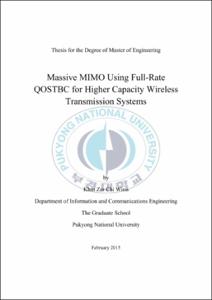Massive MIMO Using Full-Rate QOSTBC for Higher Capacity Wireless Transmission Systems
- Alternative Title
- 고용량 무선전송시스템을 위한 완전비율 준직교 공간시간 블록보호 기반의대교모 MIMO
- Abstract
- Abstract
The wireless industry has recently been introduced with a technology known as massive Multiple-Input Multiple-Output (massive MIMO) to minimize errors, to maximize performance, energy and spectral efficiency, to increase robustness and link reliability and to enhance data rates. This is implemented by using massive number of multiple transmit and receive antennas, as well as by applying quasi-orthogonal space-time block code (QOSTBC) techniques.
The advanced research area in the field of wireless communication system is to place more and more antennas either at the base station or mobile station or both sides of the communication system in order to achieve huge spectral effectiveness comparable to the conventional MIMO systems. The conventional MIMO systems have certain limitations including comparatively low achievable data rates using the transmitter with a maximum of 4 antennas, low spectral effectiveness, and less potential for large spatial dimensions.
This thesis deals with massive MIMO system performance employing the QOSTBC scheme with multiple antennas up to 128×128 configuration. The QOSTBC scheme has many advantages in terms of the higher transmission rates and lower decoding complexity. It is an important transmit diversity scheme for more than 2 transmit antennas. The antenna array configurations are classified into 2×2, 4×4, 8×8, 16×16, 32×32, 64×64 and 128×128 massive MIMO systems, which directly affect the system performance. The channel vectors are quasi orthogonal, and the interference is then reduced significantly. The users of this technology can benefit from the improved data rates while using the same frequency resource simultaneously. We present that the BER performance improves with increasing number of antennas.
Simulation results verify that the massive MIMO systems with QOSTBC can enhance performance to a full rate, as compared with other massive MIMO systems. We provide simulation results demonstrating the performance for up to 128 transmitter and receiver antennas with BPSK, QPSK, 8PSK and 16QAM modulation formats. The simulation results show how multiple transmit antennas with QOSTBC can lead to outstanding performance over additive white Gaussian noise (AWGN) and Rayleigh fading channels.
- Issued Date
- 2015
- Awarded Date
- 2015. 2
- Type
- Dissertation
- Publisher
- Pukyong National University, Master of Engineering
- Alternative Author(s)
- 킨자치윈
- Affiliation
- Master of Engineering
- Department
- 대학원 정보통신공학과
- Advisor
- Yeon-Ho Chung
- Table Of Contents
- Table of Contents
List of Figures iii
List of Tables v
List of Abbreviations vi
Acknowledgement viii
Abstract ix
1. Introduction 1
1.1 Massive MIMO Communication 1
1.2 Motivations and Research Objectives 4
1.3 Chapter Organization 4
2. Massive MIMO System Design 5
2.1 Single Input Single Output (SISO) 8
2.2 Single Input Multiple Output (SIMO) 10
2.3 Multiple Input Single Output (MISO) 11
2.4 Multiple Input Multiple Output (MIMO) 12
2.5 Multi-User MIMO (MU-MIMO) 17
2.6 Massive MIMO System 20
3. Quasi-Orthogonal Space-time Block Code 24
3.1 Space-time Code (STC) 24
3.2 Space-time Block Code (STBC) 25
3.3 Orthogonal Space-time Block Code (OSTBC) 26
3.4 Quasi-Orthogonal Space-time Block Code (QOSTBC) 30
4. Performance Analysis of Massive MIMO System35
4.1 Additive White Gaussian Noise (AWGN) Channel 35
4.1.1 SIMO 36
4.1.2 MISO 37
4.1.3 MIMO 37
4.2 Simulation Results over AWGN Channel 38
4.3 Rayleigh Fading Channel 43
4.4 Simulation Results over Rayleigh Fading Channel 45
4.5 Conclusions 51
References 53
List of Publications 58
- Degree
- Master
- Files in This Item:
-
-
Download
 Massive MIMO Using Full-Rate QOSTBC for Higher Capacity Wireless Transmission Systems.pdf
기타 데이터 / 1.62 MB / Adobe PDF
Massive MIMO Using Full-Rate QOSTBC for Higher Capacity Wireless Transmission Systems.pdf
기타 데이터 / 1.62 MB / Adobe PDF
-
Items in Repository are protected by copyright, with all rights reserved, unless otherwise indicated.